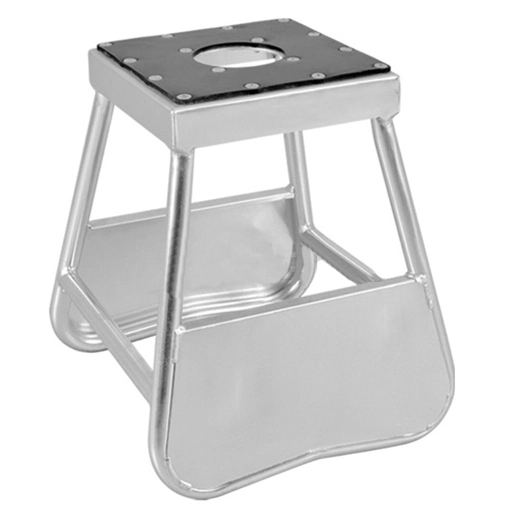The Importance of Using a Proper Motorcycle Stand
Understanding the Types of Motorcycle Stands
Motorcycle stands come in various forms, each designed for specific purposes. The most common types include paddock stands, centerstand, and sidestand. Paddock stands, often made of durable materials like aluminum, offer stability for maintenance tasks. Centerstands, integrated into some motorcycles, provide a built-in lifting solution. Sidestands, while not ideal for extensive work, offer quick parking support.
Benefits of Using a Quality Stand
Investing in a high-quality motorcycle stand yields numerous advantages. It ensures the safety of both the rider and the bike during maintenance procedures. A robust stand, particularly an aluminium motorcycle stand, offers superior stability and durability. This stability is crucial when working on your motorcycle, preventing accidental tipping and potential damage.
Choosing the Right Stand for Your Motorcycle
Selecting the appropriate stand depends on your motorcycle's make, model, and weight. Consider factors such as the stand's weight capacity, adjustability, and compatibility with your bike's frame. For sport bikes, rear paddock stands are popular, while cruisers might benefit from a front wheel chock combined with a rear stand. Always consult your motorcycle's manual for specific recommendations.
Preparing Your Motorcycle for Lifting
Safety Precautions Before Lifting
Prior to lifting your motorcycle, it’s vital to establish a safe working environment. Begin by confirming that you are on a stable, level surface free from debris or obstacles that could compromise stability. Wear protective gear, including sturdy closed-toe shoes and gloves, to minimize injury risk. If possible, enlist a helper to assist and monitor the lift, providing an extra layer of safety. Being deliberate and methodical during preparation ensures that the lifting process is controlled and reduces the chance of accidents or damage to your motorcycle.
Inspecting Your Motorcycle and Stand
Before engaging the lift, carefully inspect both your motorcycle and the aluminium motorcycle stand lift for potential issues. Check the bike for any loose bolts, accessories, or damaged components that might affect stability during elevation. Examine the stand for wear, bent parts, or loose fasteners. Pay special attention to the contact areas between the stand and motorcycle, ensuring they are clean, undamaged, and free of grease or debris. A thorough pre-lift inspection prevents unexpected movement and ensures that the motorcycle remains securely supported throughout the maintenance process.
Positioning Your Motorcycle for Optimal Lifting
Correct positioning is essential for safe and effective lifting. Place your motorcycle in an area with sufficient space around it for both access and movement. For rear stands, ensure the rear wheel is properly aligned with the lifting points. Front stands or wheel chocks require the front wheel to be straight, with the bike balanced on its sidestand. Consider marking the floor with tape to help maintain consistent positioning in future maintenance sessions. Proper placement improves stability, simplifies the lifting process, and reduces the risk of tipping or mishandling during work.
Step-by-Step Lifting Process
Engaging the Stand with Your Motorcycle
Start by carefully positioning your motorcycle stand lift in alignment with the designated lift points on your bike. For rear paddock stands, these are typically located at the swingarm spools or the ends of the swingarm itself. Slowly and steadily engage the stand, ensuring it is securely seated before applying any lifting force. Check that the stand’s feet are stable on the ground and that the contact points are properly aligned to avoid slipping. Proper alignment at this stage is essential for safe and controlled elevation of the motorcycle.
Lifting Techniques for Different Motorcycle Types
Different motorcycles require slightly different lifting approaches. Sport bikes are often lifted smoothly and evenly using a rear paddock stand, maintaining constant pressure to avoid sudden shifts. Cruisers may need a combination of a front wheel chock and rear stand for balanced elevation. Adventure or dual-sport bikes often benefit from a center stand or a specialized adventure bike lift. Regardless of the motorcycle type, always lift slowly, keep your hands steady, and monitor the bike’s movement to prevent tilting or instability during the process.
Securing Your Motorcycle Post-Lift
After the motorcycle is raised, focus on securing it to prevent accidental tipping. Confirm that the lift is fully engaged and that the bike is balanced on all points of contact. For added security, leaving the sidestand partially down can provide extra support. For longer maintenance sessions, consider using wheel chocks, tie-down straps, or additional support stands to immobilize the bike. Periodically check the stability of the motorcycle during your work to ensure it remains firmly supported and to reduce the risk of accidents while performing repairs or maintenance.
Conclusion
Lifting your motorcycle with a stand is a fundamental skill that enhances your ability to maintain and care for your bike. By following this guide, you've learned the importance of selecting the right stand, preparing properly, and executing the lift safely. Remember, practice makes perfect, and with time, you'll become more confident in handling your motorcycle for various maintenance tasks. Always prioritize safety and refer to your motorcycle's manual for specific guidance. With the right tools and knowledge, you're well-equipped to keep your motorcycle in top condition for years of enjoyable riding.
Contact Us
Ready to elevate your motorcycle maintenance game? For more information about our high-quality motorcycle stands and maintenance tools, contact us at info@runva.com.cn. Let us help you find the perfect solution for your motorcycling needs.

_1737625693698.webp)


